Fleet Management: A Complete Solution For Modern Businesses
Every vehicle your business owns is an investment, but without the right systems in place, that investment can quickly turn into a liability.
Fleet management gives you the tools to make smarter decisions about how vehicles are used, maintained, and monitored. It turns scattered information into actionable insights, helping you run leaner, safer, and more responsive operations.
Whether you’re just starting to build a fleet or looking to improve your existing one, this guide will walk you through how modern fleet management helps reduce costs, improve oversight, and keep vehicles working at their best
What Is Fleet Management?
Fleet management is the organized process of overseeing company-owned vehicles that are used for work. Everything from vehicle acquisition to maintenance, fuel tracking, driver monitoring, and compliance with safety regulations come under the umbrella of fleet management.
The goal is to ensure that vehicles are used safely, cost-effectively, and in compliance with the law. Whether leased or owned, a well-managed fleet allows businesses to serve more customers, reduce downtime, and protect their long-term investment in assets.
Why Fleet Management Is Important For Every Business?
Whether you own one truck or manage a business of 100 trucks or vehicles, fleet management plays a crucial role in keeping operations organized, cost-effective, and reliable. It helps reduce operational costs, ensure driver safety, and improve overall efficiency.
With real-time tracking and automated maintenance schedules, you can prevent downtime, cut fuel waste, and keep your vehicles performing reliably. It also simplifies compliance with regulations and protects valuable assets from misuse or theft.
Key Components Of Fleet Management
Fleet management brings several moving parts together to keep vehicle operations efficient, safe, and cost-effective. Each component plays a specific role in ensuring that business vehicles are always ready, reliable, and under control.
Below are the core components that fleet management includes:
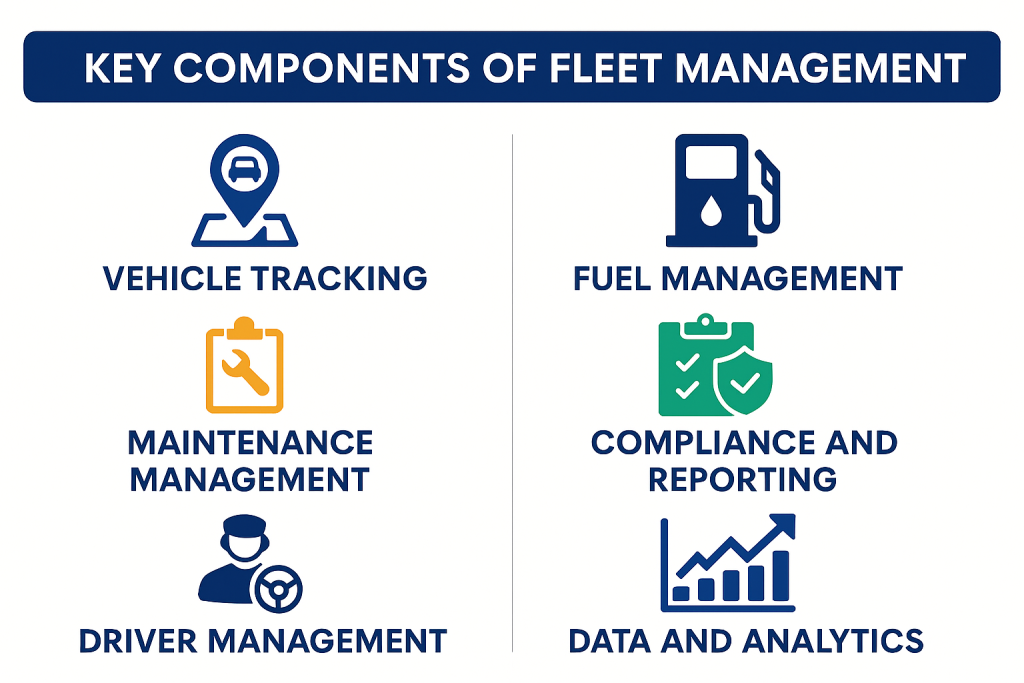
- Vehicle Tracking: Uses GPS and telematics to monitor location, movement, and status in real time
- Maintenance Management: It helps schedule inspections, track repairs, and avoid breakdowns through preventative care
- Driver Management: Covers driver assignments, behavior monitoring, and safety reporting to ensure accountability on the road
- Fuel Management: Tracks fuel usage, identifies waste, and supports cost-saving strategies
- Compliance And reporting: Keeps vehicles aligned with legal, environmental, and safety regulations through automated records and alerts
- Data And Analytics: Gathers fleet activity data to support smarter planning and decision-making
These elements work together to give businesses full visibility into their fleet and the ability to act quickly when something needs attention.
How Does Fleet Management Work?
The working strategy of fleet management remains the same across all the businesses that own or lease vehicles. The fundamental process is to keep operations smooth at all times. Below is the right working of the process:
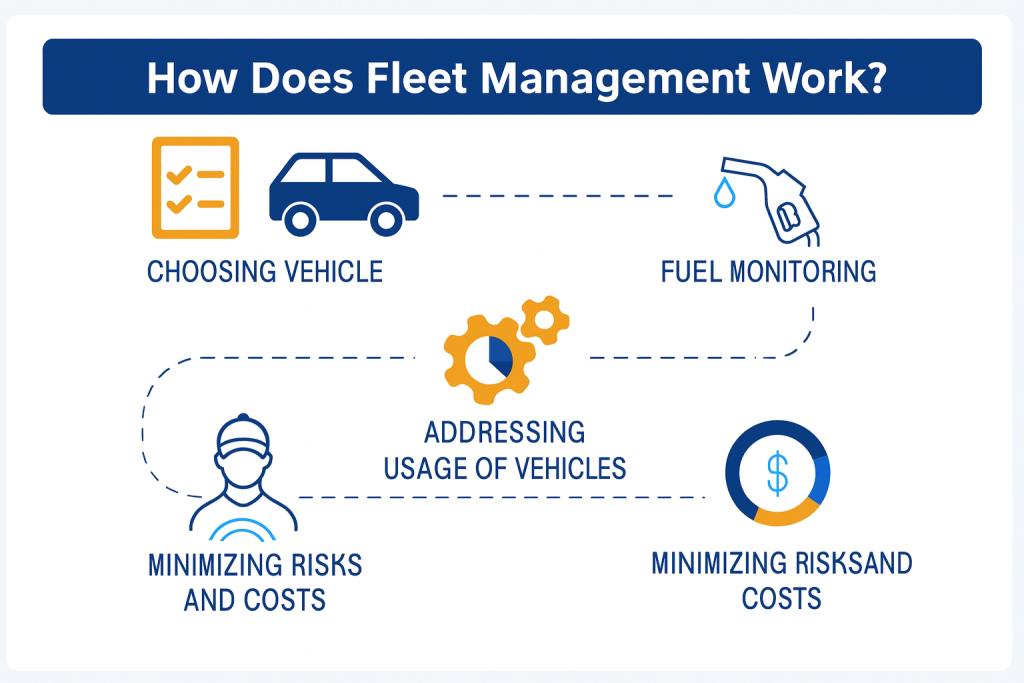
Choosing Vehicle
It starts with choosing the right vehicles. Fleet managers look at factors such as cost, fuel type, cargo capacity, and maintenance history before adding any vehicle to the fleet. A bad purchase here leads to higher repair bills or poor performance down the road. The goal is to build a lineup that fits business needs without draining the budget.
Fuel Monitoring
Fuel usage is tracked in real time across every vehicle. Managers watch for sudden spikes, waste, or signs of theft. By comparing patterns between drivers or routes, it becomes easier to cut fuel costs and plan more efficient trips. This data also helps decide when a vehicle might need servicing or replacement due to declining mileage.
Addressing The Usage Of Vehicles
Knowing about how often each vehicle is used helps avoid overworking certain assets while others sit idle. Fleet systems log mileage, usage frequency, engine hours, and trip duration. That way, managers can rotate vehicles evenly, extend lifespan, and prevent wear and tear from building up too quickly.
Behavioral Management Of Drivers
How someone drives has a big impact on fuel, safety, and repair costs. Fleet tracking tools monitor activities such as harsh braking, speeding, sharp turns, or idling. The goal isn’t to punish, but to coach better habits. Recognizing safe drivers also builds trust and accountability across the team.
Minimizing Risks And Costs
Fleet data helps businesses avoid unexpected problems and extra expenses. Regular maintenance lowers repair costs. Safe driving reduces accident risks. And better planning helps prevent delays and overtime. It all adds up to smoother operations and more control over your budget.
What Is Fleet Management Software?
Fleet management software is the system that keeps your vehicles, drivers, and maintenance organized in one place. It gives you full visibility into the location and condition of the vehicles as well as the performance of your team.
Below are the key features this kind of software offers to keep fleets running efficiently:
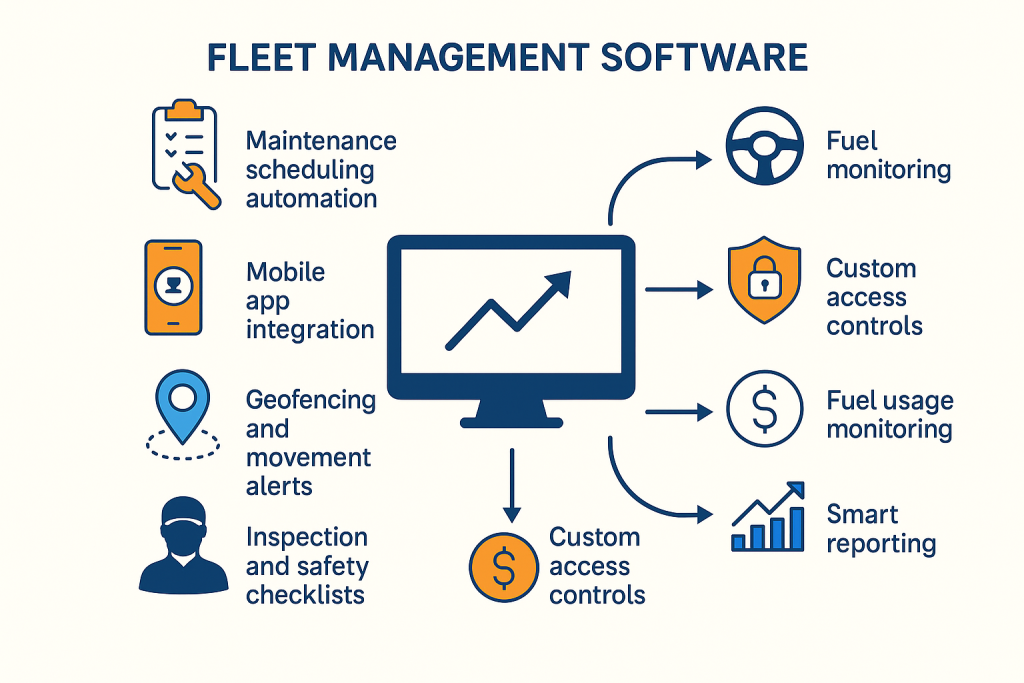
- Provides live vehicle monitoring so you always know where your assets are without the need to chase updates
- Automates maintenance scheduling by triggering service alerts before breakdowns happen
- Comes with mobile app integration that allows drivers report issues and access schedules on the move
- Sends geofencing and movement alerts the moment a vehicle crosses your defined boundaries
- Uses inspection and safety checklists to make sure pre-trip checks are logged and verifiable
- Delivers driver behavior insights that help reduce risky habits like harsh braking or speeding
- Includes custom access controls to ensure the right people see only what they need
- Tracks fuel usage monitoring in real time to uncover waste and fine-tune efficiency
- Offers smart reporting tools to help you spot trends and plan better with clean, usable data
By incorporating all these features, the right software enables you to run smarter. It keeps things running on time, ensures compliance, and gives you the tools to scale with confidence.
What Is Fleet Maintenance Management Software
Fleet maintenance management software gives you a clear picture of your vehicles’ condition before any issues arise. Instead of waiting for costly surprises, it helps you catch small issues early.
The software tracks usage, service history, and upcoming inspection needs. It sends alerts for oil changes, brake checks, or upcoming part replacements. It also logs repairs and helps flag recurring issues, so teams can tackle problems before they become costly.
Analysis tools help spot trends and forecast future needs. By focusing on early warning signs and routine upkeep, your fleet stays on the road longer, avoids unexpected expenses, and delivers reliable service, without chaos.
Challenges In Fleet Management
Running a fleet isn’t just about moving vehicles from one point to the other point. Behind the scenes, operators are juggling costs, safety, data, and compliance, all while trying to stay competitive. Without the right systems, small issues can quickly escalate into major disruptions.
Below are the most common roadblocks faced by fleet managers:
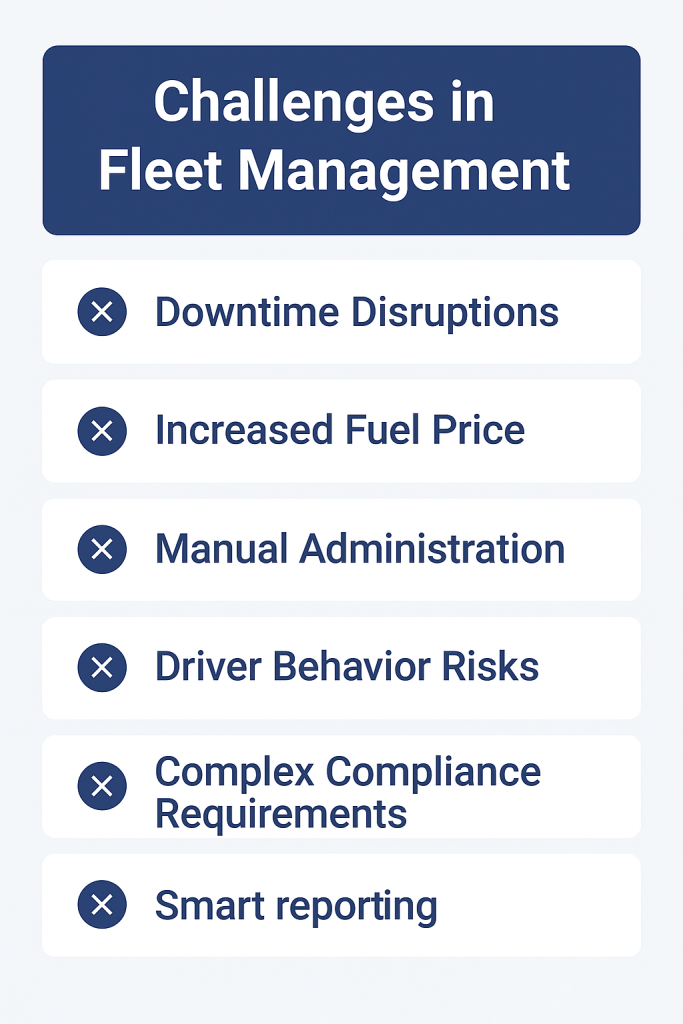
- Downtime Disruptions: Unexpected breakdowns delay deliveries, increase costs, and strain customer relationships
- Increased Fuel Price: Surging fuel prices create budgeting uncertainty and shrink profit margins
- Lack Of Real-Time Visibility: Without live data, it’s difficult to track vehicle performance or respond quickly to issues
- Manual Administration: Paper-based processes make maintenance scheduling, driver logs, and compliance reporting slow and error-prone.
- Driver Behavior Risks: Unsafe habits like speeding or harsh braking are hard to detect without digital tools, raising accident and insurance risks
- Complex Compliance Requirements: Meeting regulatory standards requires consistent recordkeeping, something many teams struggle to manage manually
Five Key Benefits Of Fleet Management
Despite the challenges, modern fleet management offers powerful tools that turn complexity into clarity. With the right strategies and software, businesses can improve safety, cut costs, and scale without added overhead.
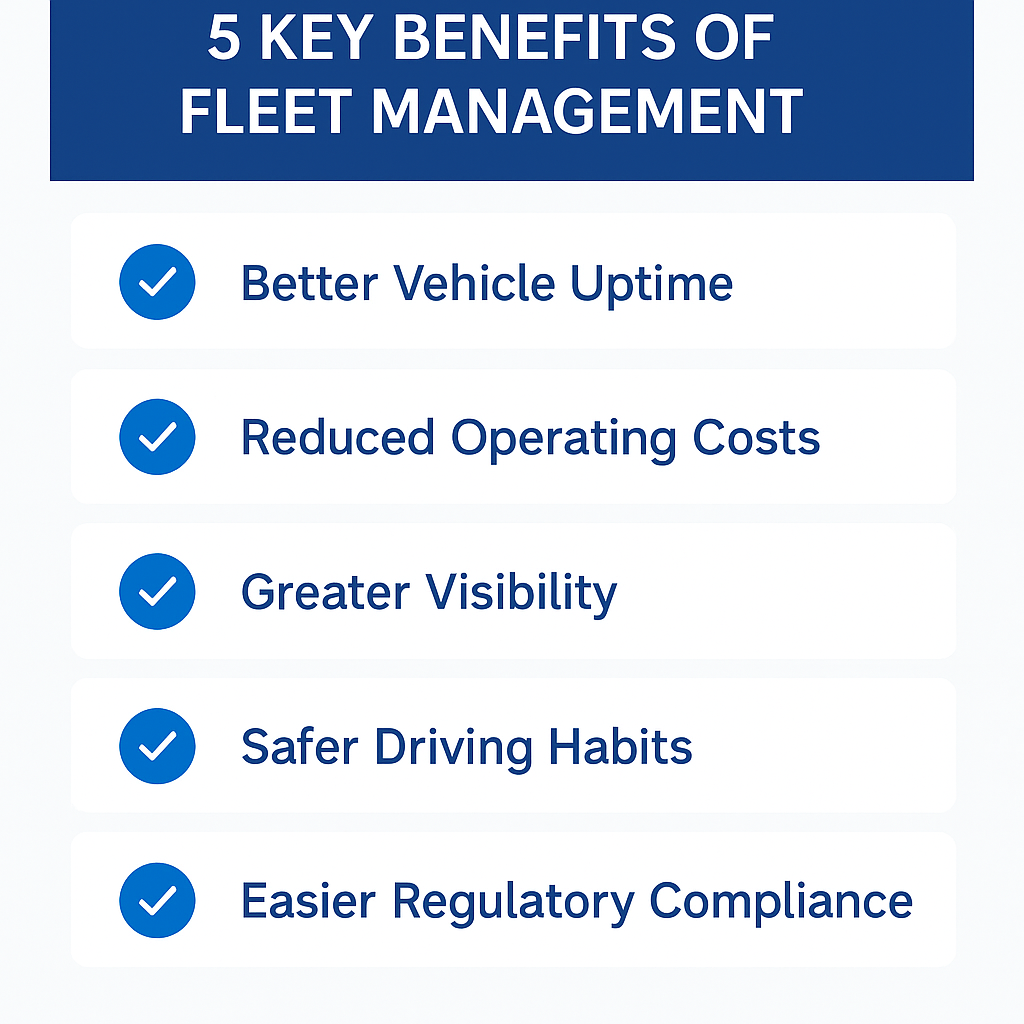
1. Better Vehicle Uptime
Scheduled maintenance alerts help prevent surprise breakdowns, keeping your fleet road-ready.
2. Reduced Operating Costs
Real-time tracking and fuel monitoring eliminate inefficiencies and reduce waste across operations.
3. Greater Visibility
Fleet managers get a full picture of vehicle locations, driver activity, and service status at any time.
4. Safer Driving Habits
Driver analytics highlight risky behaviors, making it easier to coach teams and reduce incident rates.
5. Easier Regulatory Compliance
Automated logs and digital checklists simplify inspections, reporting, and audit preparation.
6. Scalable Operations
As your business grows, software helps manage more assets without adding an administrative burden.
How To Start Fleet Management Efficiently
Getting started with fleet management doesn’t require a massive overhaul. However, it starts with organizing what you already have. Follow these steps below to get your fleet on track from day one:
- List All Vehicles And Assets: Begin by listing your vehicles, understanding their condition, and assigning responsible drivers. This gives you a baseline to work from
- Define Clear Fleet Goals: Next, set clear goals. Do you want to reduce fuel costs? Improve driver safety? Cut down on unplanned repairs? Defining your priorities helps you choose tools that actually solve your problems
- Choose A Fleet Management Platform: From there, select software that fits your needs. Look for something easy to use, with strong reporting features and mobile access. You don’t need the most expensive tool, just one that gives you visibility into your fleet and supports your day-to-day tasks
- Train Drivers And Fleet Staff: Finally, involve your team. Train drivers and managers so everyone knows how to log data, respond to alerts, and follow maintenance schedules. The more aligned your team is, the more value you’ll see from your system
- Track Key Metrics: Set KPIs and review improvements after 30–60 days
Final Words: Simplify Your Operations With The Right Fleet Management Solution
Running a fleet means more than just keeping vehicles moving; it’s about making informed decisions that protect your assets, reduce risk, and support your team. With the right tools in place, you gain the visibility and control needed to operate efficiently, cut costs, and scale without stress. Now is the time to take charge and build a fleet strategy that works as hard as you do.
Still confused about how to manage your fleet? Discover our fleet management service or contact our team of experts to learn more about fleet management solutions.
This Blog is written by Ayesha Suleman




